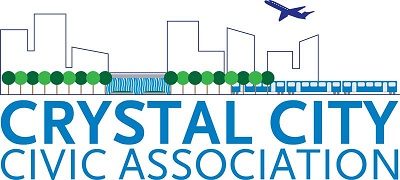History of Crystal City
(From Crystal City Sector Plan, Arlington County, 2010, Chapter 1.1.1: http://arlingtonva.s3.amazonaws.com/wp-content/uploads/sites/5/2014/03/sprc_Jul3012_SectorPlan_CrystalCityPO.pdf)
Crystal City has benefitted from its location across the Potomac River from Downtown Washington, D.C. and proximity to a major crossroads of regional transportation and transit facilities. Since the founding of the Federal City, waterways, railroads, bridges, highways, and airports have provided easy access to and from this location, shaping its evolution and making Crystal City a prime location for commercial and residential growth. Before 1960, much of Crystal City was devoted to low intensity industrial uses such as brickyards, warehouses, and other construction related activities. Auto-oriented and rail-associated uses such as motels, storage yards, iron fabricating factories, junk yards, and a drive in theater prevailed along with many vacant and underutilized tracts. However, the corridor’s proximity to Reagan National Airport, the Pentagon, and Washington, D.C. soon stimulated major redevelopment initiatives for the area. In the mid-1960s, a growing demand for office space outside of the Washington, D.C., central business district made Arlington locations more attractive and led to Crystal City’s early development into an urban center. Crystal City’s first generation of planned development comprised mixed-use development of office, apartment, and hotel buildings, with an internal retail spine located east of Jefferson Davis Highway. The name “Crystal City” was taken from one of the early apartment buildings, the Crystal House (1900 S. Eads Street), and the large crystal chandelier that graced its lobby. As development continued, new apartment and hotel buildings were constructed west of Jefferson Davis Highway. Meanwhile, the federal government’s decision in the late 1960s to locate the U.S. Patent Office and the Institute of Defense Analysis in Crystal City stimulated more construction of office and residential buildings supporting federal government uses. With the July 1977 opening of the Crystal City Metro Station, and the Virginia Railway Express (VRE) station a few years later, Crystal City’s market reach was greatly expanded, positioning it as a major regional employment center. Millions of square feet of mixed use development have been built to date, leading to Crystal City’s status as one of the region’s primary activity centers. .
.
(From Wikipedia: https://en.wikipedia.org/wiki/Crystal_City,_Arlington,_Virginia)
Before development by the Charles E. Smith Co., the area was mostly composed of industrial sites, junkyards, and low-rent motels. A drive-in theater existed at the intersection of Jefferson Davis Highway and 20th Street South between 1947 and 1963 and is visible on aerial photos of the period. The RF&P railroad tracks were moved closer to National Airport to accommodate more space for development.
Though it is not a planned community, it unfolded in much that fashion after construction began on the first few condominiums and office buildings in 1963. The name “Crystal City” came from the first building, which was called Crystal House and had an elaborate crystal chandelier in the lobby. Every subsequent building took on the Crystal name (e.g., Crystal Gateway, Crystal Towers) and eventually the whole neighborhood. Crystal City is largely integrated in layout and extensive landscaping, as well as the style and materials of the high rise buildings, most of which have a speckled granite exterior.
Crystal City’s Crystal Underground shopping mall opened in September 1976. Billed as a “turn-of-the-century shopping village,” it featured antique leaded glass shop windows and cobblestone “streets.” Emphasis was on locally owned and operated businesses and personalized service. The largest retail outlets were a 12,000-square-foot (1,100 m2) Jelleff’s women’s store, Larimers gourmet grocery and delicatessen, and a Drug Fair. The mall also featured an “Antique Alley” with small antique and craft stores. At opening there were 40 stores, with an anticipated expansion of 150,000 square feet (14,000 m2) with 70 more shops including the Crystal Palace food court.[2]
On June 26, 2004, the Crystal City area underwent a number of changes. Many buildings’ addresses were changed on this date, several major roads were turned into two-way streets, and many of the markings for the traditional building names (e.g., “Crystal Gateway 1”) were removed. As a result, local residents may refer to building names that are difficult for visitors to find.[3]
